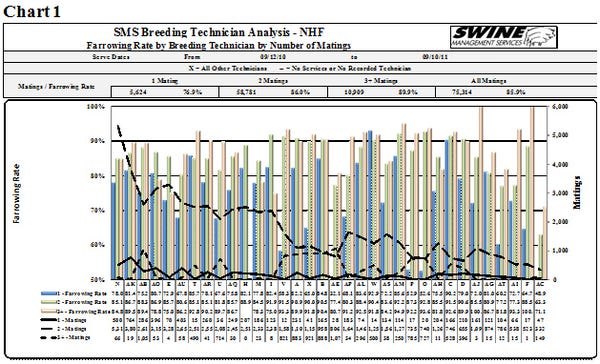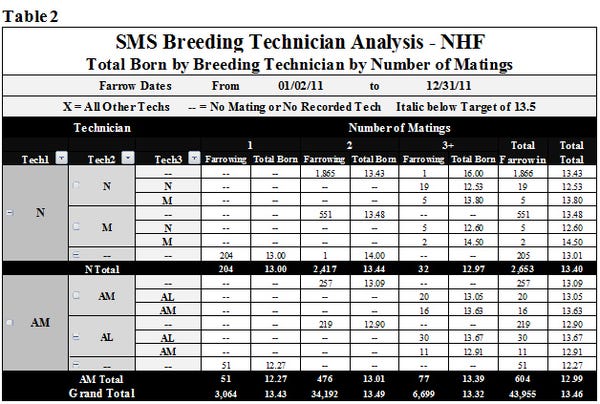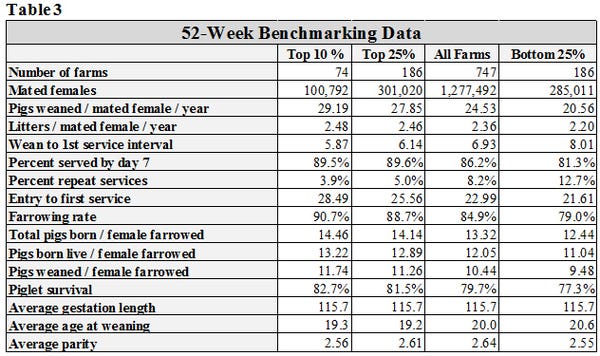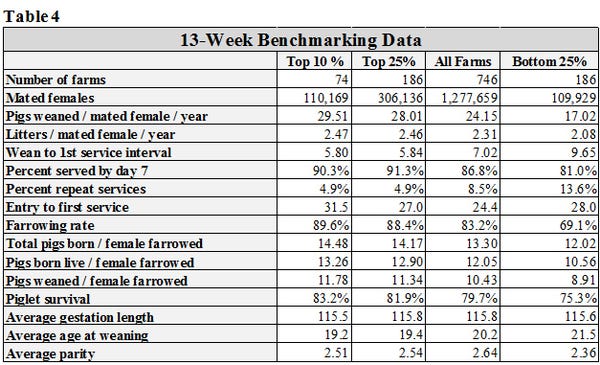March 12, 2012

When we looked at the Swine Management Services (SMS) database for the last 52 weeks, the average farrowing rate for 754 farms was 85%, with the top 10% of farms at 90.3% and the bottom 25% at only 79.2%.
We see a lot of variation in total pigs born/litter. The top 10% averaged 14.42 pigs/litter, while the bottom 25% was 12.40 pigs/litter. The average for all farms was 13.33 pigs/litter.
Clearly, both farrowing rate and total pigs born are affected by many factors, but for this column we will focus on the impact breeding technicians have on these measures of female performance.
To help farms improve farrowing rate and total pigs born/litter we have developed six new, very detailed reports for our Breeding Analysis Program. The first four reports look at performance of individual breeding technicians by the number of services, number of matings, wean-to- service interval, return interval, parity, day of week bred, hour of day bred and semen batch code or boar identification. These reports are labeled:
· Breeding Technician Analysis Farrowing Rate Charts
· Breeding Technician Analysis Farrowing Rate Report
· Breeding Technician Analysis Total Born Charts
· Breeding Technician Analysis Total Born Report.
This approach allows us to look at each breeding technician's results for sows farrowed in the most recent 26 weeks, plus the conception rate for females bred the last 17 weeks. This also helps us track any changes in breeding procedures or how a new breeding technician is doing by looking at groups of sows that have not farrowed yet.
The fifth and sixth reports of the Breeding Analysis Report are:
· In-Depth Analysis
· Breeding Weekly Analysis
These reports study the last 24 weeks and 26 weeks on how breeding groups were put together and where the fallout of return females is coming from. By looking at the details of the last 26 breeding groups, by week, we can identify areas to focus on to improve farrowing rate.
The dataset for this article was compiled from 11 U.S. and Canadian farms. To be included, a breeding technician had to average more than 10 matings/week. The dataset features 34 breeding technicians, a total of 80,013 matings, an average farrowing rate of 86.0%, and 13.46 total born/female farrowed for 52 weeks ending Dec. 31, 2011.
The data required for each mating includes female identification (ID), breeding technician ID, semen batch code or boar ID, and the time of the day the mating occurred in military time (01-24). Some programs do not allow the time of day (hour) to be reported.
In last week’s column, “New Breeding Analysis Program Helps Identify Best Breeding Technician,” we looked at technicians by number of services. This article will focus on farrowing rate and total born by number of matings.
Chart 1 and Table 1 show farrowing rate by number of matings by breeding technician. Chart 1, with 75,314 females mated, shows that 7.4% of the females were mated only once, while 14.5% of females were mated three or more times. Farrowing rate improved as the number of matings increased – single matings, 76.9%; two matings, 86%; and three or more matings, 89.9%.


When we analyze farm records, we see a lot of variation in the number of matings/service period. Some farm protocols only allow the technician to breed a female once per day and limit the number of days a female can be bred to two days. If a farm has more than 2-3% single matings, a review of the records is needed to see if the drop in farrowing rate is due to a technician, a certain parity, etc. This will allow breeding protocols to be adjusted.
For example, the technician may need additional training or the breeding procedure may be shifted to breeding select females twice the first day in heat (e.g., an AM insemination followed by a PM insemination at least six hours later). In our analysis, we have found that most of the single matings are gilts, returns to estrus and females cycling six days or later after weaning.
Table 1 shows three (N, T, U) of the 34 breeding technicians used in the dataset. For the 52-week period, Tech N had 501 females mated once, 4,260 females mated twice, 39 females mated three times, with farrowing rates of 84.9%, 84.6% and 78%, respectively. Tech U had only 37 females mated once, 2,018 females mated twice, 710 females mated three times, with farrowing rates of 68.6%, 81.7% and 89.5%, respectively.
Drilling deeper, the next step would be to take a closer look at the number of matings by parity or, possibly, by day of the week bred so minor adjustments to breeding protocols could be made to reduce single matings and improve farrowing rates.
Chart 2 and Table 2 show total born by breeding technician and by number of matings on the same set of females farrowed. Looking at total born by number of matings, we see females bred just once averaged 13.43 pigs/litter, those mated twice had 13.49 pigs/litter and those mated three times or more averaged 13.32 pigs/litter. The overall average was 13.46 pig/litter.

Now, if we narrow our focus to technicians in which at least 100 litters were farrowed, performance ranges from 12.07 to 14.83 pigs/litter with single matings vs. a range of 13.31 to 14.34 pigs/litter for females bred three times or more.

In Table 2, Tech N had 205 single-mated females with total born averaging 13.01 pigs/litter, double-mated females averaged 13.34 pigs/litter, and only 19 females mated three or more times averaging 12.53 pigs/litter. Tech AM had 51 females mated once and averaged 12.27 pigs/litter, 476 mated twice with 13.01 pigs/litter, and, with three or more matings, 77 females averaged 13.39 pigs/litter.
We have seen cases where the main technician on a farm had a total born average of one pig/litter less than other technicians. On one farm, after reviewing breeding techniques, some changes were made to get technicians to do a better job of stimulating females at breeding to see if total pigs born/litter could be improved.
In conclusion, it is important to know how well each breeding technician is performing – measured by farrowing rate and total pigs born/litter. If a breeding technician is having a large number of single matings, some changes in breeding protocol should be made. If that involves buying a few more bags of semen or having someone stay late to do PM matings on a few gilts or returns, those changes need to be made. A 1% improvement in farrowing rate could mean an extra 0.34 pigs/sow/year.
At SMS, we are constantly looking for new ways to analyze data and present it in a format that is easier for farm staff to understand. When a problem is identified, we offer new ideas on how to manage the highly prolific females available today.
Key Performance Indicators
Tables 3 and 4 (below) provide 52-week and 13-week rolling averages for key performance indicators (KPI) of breeding herd performance. These tables reflect the most current quarterly data available and are presented with each column. The KPI’s can be used as general guidelines to measure the productivity of your herd compared to the top 10% and top 25% of farms, the average performance for all farms, and the bottom 25% of farms in the SMS database.

If you have questions or comments about these columns, or if you have a specific performance measurement that you would like to see benchmarked in our database, please address them to: [email protected]or [email protected]

You May Also Like



